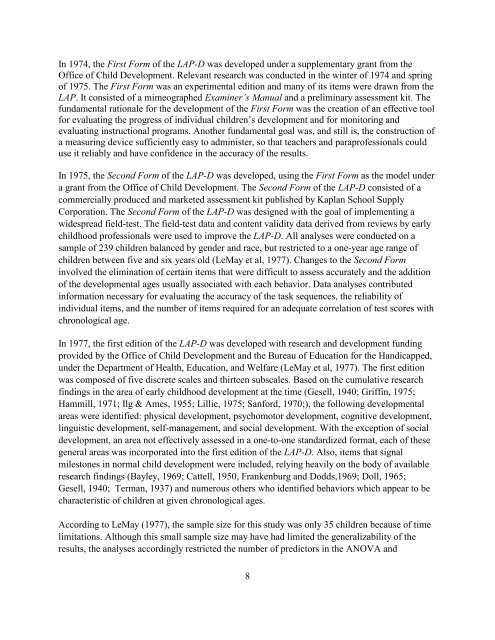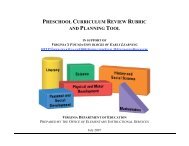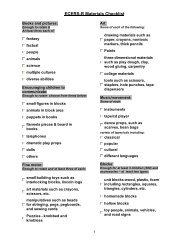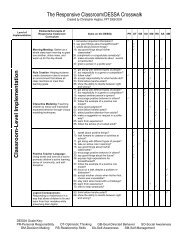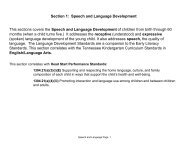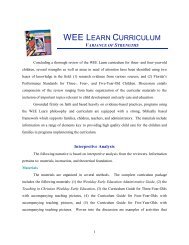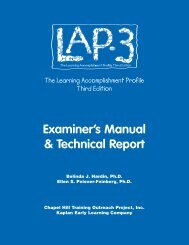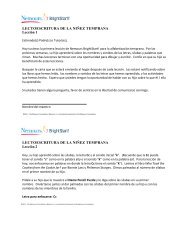In 1974, the First Form of the LAP-D was developed under a supplementary grant from theOffice of Child Development. Relevant research was conducted in the winter of 1974 and springof 1975. The First Form was an experimental edition and many of its items were drawn from theLAP. It consisted of a mimeographed Examiner’s <strong>Manual</strong> and a preliminary assessment kit. Thefundamental rationale for the development of the First Form was the creation of an effective toolfor evaluating the progress of individual children’s development and for monitoring andevaluating instructional programs. Another fundamental goal was, and still is, the construction ofa measuring device sufficiently easy to administer, so that teachers and paraprofessionals coulduse it reliably and have confidence in the accuracy of the results.In 1975, the Second Form of the LAP-D was developed, using the First Form as the model undera grant from the Office of Child Development. The Second Form of the LAP-D consisted of a<strong>com</strong>mercially produced and marketed assessment kit published by Kaplan School SupplyCorporation. The Second Form of the LAP-D was designed with the goal of implementing awidespread field-test. The field-test data and content validity data derived from reviews by earlychildhood professionals were used to improve the LAP-D. All analyses were conducted on asample of 239 children balanced by gender and race, but restricted to a one-year age range ofchildren between five and six years old (LeMay et al, 1977). Changes to the Second Forminvolved the elimination of certain items that were difficult to assess accurately and the additionof the developmental ages usually associated with each behavior. Data analyses contributedinformation necessary for evaluating the accuracy of the task sequences, the reliability ofindividual items, and the number of items required for an adequate correlation of test scores withchronological age.In 1977, the first edition of the LAP-D was developed with research and development fundingprovided by the Office of Child Development and the Bureau of Education for the Handicapped,under the Department of Health, Education, and Welfare (LeMay et al, 1977). The first editionwas <strong>com</strong>posed of five discrete scales and thirteen subscales. Based on the cumulative researchfindings in the area of early childhood development at the time (Gesell, 1940; Griffin, 1975;Hammill, 1971; Ilg & Ames, 1955; Lillie, 1975; Sanford, 1970;), the following developmentalareas were identified: physical development, psychomotor development, cognitive development,linguistic development, self-management, and social development. With the exception of socialdevelopment, an area not effectively assessed in a one-to-one standardized format, each of thesegeneral areas was incorporated into the first edition of the LAP-D. Also, items that signalmilestones in normal child development were included, relying heavily on the body of availableresearch findings (Bayley, 1969; Cattell, 1950, Frankenburg and Dodds,1969; Doll, 1965;Gesell, 1940; Terman, 1937) and numerous others who identified behaviors which appear to becharacteristic of children at given chronological ages.According to LeMay (1977), the sample size for this study was only 35 children because of timelimitations. Although this small sample size may have had limited the generalizability of theresults, the analyses accordingly restricted the number of predictors in the ANOVA and8
egression procedures. This study extended the age range of the sample beyond the previousstudy to children between 30 and 73 months of age (mean = 46.63 months, SD = 11.7 months).From 1977-1992, early childhood educators across the United States used the first edition of theLAP-D, which was a criterion-referenced instrument. A number of local pilot studies, such asone conducted with over 800 kindergarten children in Kentucky in 1978-79, reported favorablyon the assessment’s reliability and validity.In 1992, with the expansive growth of preschool programs in the first 15 years since theinstrument was developed, the demand for norm-referenced assessments appropriate for youngchildren increased. In response to numerous requests, the publisher in collaboration with CHTOPinitiated a study to revise, standardize, and norm the second edition of the LAP-D. A select teamof professionals, including psychologists, teachers, administrators, and other early childhoodeducators, assisted in the review of the final revisions to the LAP-D.Changes to the second edition of the LAP-D included new, updated color illustrations; a newmanual format with more explicit written procedures, instructions, and scoring criteria; new,updated, standardized materials in the assessment kit; deletion of items with little or nodiscrimination and minimal educational value; a revised Scoring Booklet; an updated andexpanded Examiner’s <strong>Manual</strong>; and the addition of a <strong>Technical</strong> <strong>Report</strong> describing thestandardization study. The Self-Help subscales found in the first edition of the LAP-D weredeleted since they were originally designed for children ages birth to 36 months and because thesecond edition of the LAP-D was standardized on children ages 30 to 72 months, there were noempirical data supporting the validity of these scales.In 2002, CHTOP received funding to re-norm the LAP-D in English and to translate/adapt andestablish norms for a Spanish version of the LAP-D. CHTOP coordinated the translation/adaptation of the LAP-D into Spanish in collaboration with the Miami-Dade School ReadinessCoalition. Once the translation/adaptation was <strong>com</strong>pleted, a pilot study was conducted thatincluded 92 children representing different ages, race and ethnicity, gender, socioeconomicstatus, and types of program settings. Each child was administered the LAP-D and the PeabodyPicture Vocabulary Test-III (PPVT-III) or Test de Vocabulario en Imágenes Peabody (TVIP) intheir primary language (English or Spanish). These data were analyzed and changes were madeto the Spanish version to create the field test edition used in the norming study. In addition,changes were made to the English version of the LAP-D to ensure the consistency of theinstrument across languages. Once these changes were <strong>com</strong>pleted, the field test edition of theLAP-D in both languages was used for the norming study.To re-norm the LAP-D in English and standardize the Spanish LAP-D, a sample of 2099 childrenparticipated in the study from five areas throughout the United States representing different ages,race and ethnicity, gender, socioeconomic status, rural/urban settings, and types of programsettings participated in the study. Recruitment and data collection took place from October, 2002through January, 2004. The study included 1124 English-speaking children and 975 Spanishspeakingchildren. The results suggest that the LAP-D is a reliable and valid measure forassessing the skill development of both English- and Spanish-speaking children. Study results9
- Page 3 and 4: Initial DevelopmentDavid Wilson LeM
- Page 6 and 7: About the AuthorsBelinda J. Hardin
- Page 8 and 9: Interpreting LAP-D Profiles........
- Page 10 and 11: validity, in English and Spanish?
- Page 12 and 13: the LAP-D Third Edition is comprise
- Page 15: Chapter 2Overview of the LAP-DThis
- Page 19 and 20: Table 1. Subscales of the LAP-DDoma
- Page 21: LAP-D Scoring Booklet. The Scoring
- Page 24 and 25: ecomes inattentive or severely dist
- Page 26 and 27: --When borrowing a month, borrow 30
- Page 28 and 29: Determining Starting PointsOnce the
- Page 30 and 31: Scoring Procedures RulesOnce the st
- Page 32 and 33: Figure 3a. Determining the BasalJOR
- Page 34 and 35: Ceiling RulesThe child’s ceiling
- Page 36 and 37: Additional Scoring Rules1. Administ
- Page 38 and 39: Figure 5. Computing Raw ScoresDEVAG
- Page 40 and 41: complete the Scoring Summary & Prof
- Page 42 and 43: Figure 7: Shanika’s Scoring Summa
- Page 44 and 45: Figure 9: Alan’s Scoring Summary
- Page 46 and 47: Communicating Assessment Results to
- Page 48 and 49: of training and experience required
- Page 50 and 51: sessions, one to three weeks apart,
- Page 52 and 53: Changes were made to the translatio
- Page 54 and 55: 60-65 months 183 62.4 001.8 194 62.
- Page 56 and 57: Table 6. Adults and Number of Child
- Page 58 and 59: Prior to selection of the criterion
- Page 60 and 61: additional 409 children (19.5%; n=2
- Page 62 and 63: means, standard deviations, and cor
- Page 64 and 65: • Comprehension30-35 months 99 08
- Page 66 and 67:
Table 12b. Internal Consistency of
- Page 68 and 69:
Table 13b. Standard Errors of Measu
- Page 70 and 71:
Test-retest reliability was determi
- Page 72 and 73:
speaking children, 8.62% were Black
- Page 74 and 75:
Table 17b. Means, Standard Deviatio
- Page 76 and 77:
Table 18b. Zero-order Correlations
- Page 78 and 79:
Table 20. Correlations Between LAP-
- Page 80 and 81:
Table 23 depicts the means, standar
- Page 82 and 83:
Age Equivalent ScoresAn age equival
- Page 85 and 86:
ReferencesAmerican Educational Rese
- Page 87 and 88:
Errata for theExaminer’s Manual &
- Page 89 and 90:
Table A-1. Percentile Rank, NCE, t-
- Page 91 and 92:
Table B-2. Percentile Ranks for LAP
- Page 93 and 94:
Table B-4. Percentile Ranks for LAP
- Page 95 and 96:
Table B-6. Percentile Ranks for LAP
- Page 97 and 98:
Table B-8. Percentile Ranks for LAP
- Page 99 and 100:
Table B-10. Percentile Ranks for LA
- Page 101 and 102:
Table B-12. Percentile Ranks for LA
- Page 103 and 104:
Table B-14. Percentile Ranks for LA
- Page 105 and 106:
30-35 MONTHS 36-41 MONTHS 42-47 MON
- Page 107 and 108:
30-35 MONTHS 36-41 MONTHS 42-47 MON
- Page 109 and 110:
Table C-1. Percentile Ranks for LAP
- Page 111 and 112:
Table C-3. Percentile Ranks for LAP
- Page 113 and 114:
Table C-5. Percentile Ranks for LAP
- Page 115 and 116:
Table C-7. Percentile Ranks for LAP
- Page 117 and 118:
Table C-9. Percentile Ranks for LAP
- Page 119 and 120:
Table C-11. Percentile Ranks for LA
- Page 121 and 122:
Table C-13. Percentile Ranks for LA
- Page 123 and 124:
Table C-15. Percentile Ranks for To
- Page 125:
Table C-16. Spanish Age Equivalents


